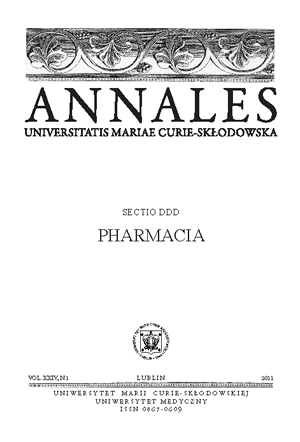Ocena antynocyceptywnych efektów topiramatu w teście przeciągania u myszy
Słowa kluczowe:
Topiramat, antynocycepcja, test przeciągania, myszyAbstrakt
W prezentowanej pracy oceniano antynocyceptywną aktywność topiramatu (TPM), leku przeciwpadaczkowego nowej generacji o złożonym mechanizmie działania, w teście przeciągania u myszy. Wykazano, iż TPM podawany w dawkach 25, 50 i 100 mg/kg wykazywał właściwości antynocyceptywne. Zmniejszenie aktywności antynocyceptywnej TPM przez nalokson, jak również brak interakcji pomiędzy TPM a morfiną, sugeruje, że receptory δ-opioidowe są zaangażowane w obserwowane efekty TPM. Dodatkowo antynocyceptywne działanie progowej dawki TPM było istotnie nasilane przez etanol, co może świadczyć o wpływie obydwu substancji na układ GABA-ergiczny i/lub aminokwasów pobudzających, jak również może wskazywać na udział w obserwowanych receptorów δ-opioidowych. Jakkolwiek, brak interakcji pomiędzy TPM a ketaminą lub diazepamem wydaje się podważać rolę układu GABA-ergicznego i układu aminokwasów pobudzających w mechanizmie działania TPM.
Podsumowując, nasze badania potwierdzają skuteczność TPM w teście przeciągania u myszy i wydają się sugerować przynajmniej częściowy udział układu opioidowego w przeciwbólowym mechanizmie działania tego leku. Niemniej jednak, kolejne badania w tym kierunku są wymagane.
Bibliografia
1. Calabresi P. et al.: Antiepileptic drugs in migraine: from clinical aspects to cellular mechanisms. Trends Pharmacol. Sci., 28, 188, 2007.
2. Carmona S., Bruera O.: Prophylactic treatment of migraine and migraine clinical variants with topiramate: an update. Ther. Clin. Risk Manag., 5, 661, 2009.
3. Dahlöf C. et al.: The impact of migraine prevention on daily activities: a longitudinal and responder analysis from three topiramate placebo-controlled clinical trials. Health Qual Life Outcomes, 5, 56, 2007.
4. Donofrio P.D. et al.: Safety and effectiveness of topiramate for the managament of painful diabetic peripheral neuropathy in an open-label extension study. Clin. Ther., 27, 1420, 2005.
5. Edvinsson L., Linde M.: New drugs in migraine treatment and prophylaxis: telcagepant and topiramate. New Drugs Class, The Lancet, 376, 645, 2010.
6. Edwards K.R. et al.: Efficacy and safety of topiramate in the treatment of painful diabetic neuropathy: A double-blind, placebo-controlled study. Neurology, 54 (Suppl 3): A81, Abstract, 2000.
7. Ferrante F.M.: The pharmacologic managament of neuropathic pain. Semin Anesth, Perioperative Medicine and Pain, 22, 168, 2003.
8. Ferraro D., Di Trapani G.: Topiramate in the prevention of pediatric migraine: literature review. J. Headache Pain, 9, 147, 2008.
9. Fidecka S. et al.: The development of cross tolerance between ethanol and morphine. Pol. J. Pharmacol. Pharm., 38, 277, 1986.
10. Fleming M., Mihic S.J., Harris R.A.: Ethanol. In: Goodman and Gilman’s: The Pharmacological Basis of Therapeutics, 11th edn. Eds. Brunton LL, Lazo JS, Parker KL, McGraw-Hill, USA, 591, 2006.
11. Gilron I. et al.: Topiramate in trigeminal neuralgia: a randomized, placebo-controlled multiple crossover pilot study. Clin Neuropharmacol, 24, 109, 2001.
12. Golden A.S., Sheryl R.H., Solomon L.M.: Nonepileptic uses of antiepileptic drugs in children and adolescents. Pediatr Neurol, 34, 421, 2006.
13. Guay D.R.: Adjunctive agents in the management of chronic pain. Pharmacotherapy, 21, 1070, 2001.
14. Gutstein H.B., Akil H.: Opioid analgesics. In: Goodman and Gilman’s: The Pharmacological Basis of Therapeutics, 11th edn. Eds. Brunton LL, Lazo JS, Parker KL, McGraw-Hill, USA, 547, 2006.
15. Koster R., Anderson M., De Beer E.J.: Acetic acid for analgesic screening. Fed. Proc., 18, 412, 1959.
16. Langtry H.D., Gillis J.C., Davis R.: Topiramate. A review of its pharmacodynamic and pharmacokinetic properties and clinical efficacy in the managament of epilepsy. Drugs, 54, 752, 1997.
17. Le Bars D., Gozariu M., Cadden S.W.: Animal models of nociception. Pharmacol. Rev., 53, 597, 2001.
18. Lopes L.S.: Antinociceptive effect of topiramate in models of acute pain and diabetic neuropathy in rodents. Life Sci., 84, 105, 2009.
19. Matosiuk D.: Synthesis and pharmacological activity of new carbonyl derivatives of 1-aryl-2-iminoimidazolidine. Part 2. Synthesis and pharmacological activity of 1,6-diaryl-5,7(1H)dioxo-2,3-dihydrimidazo[1,2-a][1,3,5]triazines. Eur. J. Med. Chem., 37, 761, 2002.
20. Pappagallo M.: Newer antiepileptic drugs: possible uses in the treatment of neuropathic pain and migraine. Clin. Ther., 25, 2506, 2003.
21. Rosenfeld W.E.: Topiramate: a review of preclinical, pharmacokinetic, and clinical data. Clin Ther, 19, 1294, 1997.
22. Ruiz L.: Topiramate in migraine progression. J Headache Pain, 2009, 10, 419, 2009.
23. Shannon H.E., Eberle E.L., Peters S.C.: Comparison of the effects of anticonvulsant drugs with diverse mechanisms of action in the formalin test in rats. Neuropharmacology, 48, 1012, 2005.
24. Silberstein S.D.: Topiramate monotherapy in epilepsy and migraine prevention. Clin Ther, 27, 154, 2005.
25. Stepanović-Petrović R.M.: The antinociceptive effects of anticonvulsants in a mouse visceral pain model. Anesth. Analg., 106, 1897, 2008.
26. Talarek S., Fidecka S.: Role of nitric oxide in benzodiazepi es-induced antinociception in mice. Pol. J. Pharmacol. 54, 27, 2002.
27. Tabakoff B., Hoffman P.: Biochemical pharmacology of alcohol. In: Psychopharmacology. Ed. Meltzer H.Y., The Third Generation of Progress. Raven Press, New York, 1521, 1987.
28. Thienel U.: Topiramate in painful diabetic polyneuropathy: findings from three double-blind placebo-controlled trials. Acta. Neurol. Scand., 110, 221, 2004.
29. Vogel G.H., Vogel W.H.: Drug Discovery and Evaluation, Pharmacological Assays Springer-Verlag, Berlin, 382, 1997.
30. Wieczorkiewicz-Płaza A.: Effect of topiramate on mechanical allodynia in neuropathic pain model in rats. Pol. J. Pharmacol., 56, 275, 2004.
Pobrania
Opublikowane
Numer
Dział
Licencja
Prawa autorskie (c) 2011 Autorzy

Praca jest udostępniana na licencji Creative Commons Attribution-NonCommercial-NoDerivatives 3.0 Unported License.


